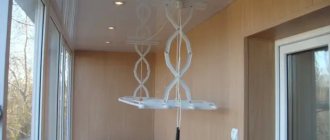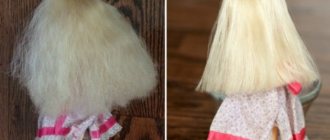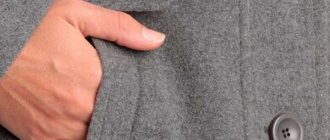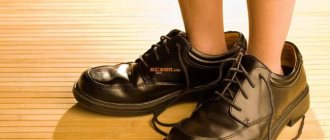Making a shoe dryer at home
Rainy weather can cause illness if you do not dry your shoes thoroughly after leaving the house again.
In order for your shoes to dry quickly, you can put them on a heater, in a microwave oven, which we do not recommend under any circumstances, or you can make a real shoe dryer yourself, especially since this does not require particularly expensive materials and special knowledge. Before you begin the manufacturing process, we present to your attention a video on how to make a dryer
What do we need: - cooler; — distribution box for electrics; - electrical tape; - stationery knife; — 12 volt power supply; - connector for power supply; - toggle switch; - wiring; - soldering iron; - glue gun; — flexible corrugated tube.
Let's get started. First of all, we need to cut a round hole on the cover of the distribution box to the diameter of the computer cooler. We will do this using a stationery knife.
After we have cut out the hole, we can glue the cooler to the lid. Please note that after gluing, the side with the manufacturer's inscription is on the top.
Now we put all this aside for a while and move on to the manufacture of the next components. To do this, take a corrugated tube and cut it in half.
There are special holes on the distributor box that need to be cut and the tube glued into them.
On the back side of the same box we make a hole for the power supply connector.
Glue the connector from the inside using a glue gun.
Next we need to decide on the location of the switch. The author, for example, put the toggle switch on the side. Again, cut a hole to fit the size of the switch and glue the toggle switch from the inside with a glue gun.
Now we need a small wire to solder our circuit.
We take the wiring and solder it to one of the contacts of the switch already installed in its place.
We solder the same wiring at the other end to the central contact of the power supply connector.
Next, take our lid with a cooler. The red wire coming from the cooler is positive. We solder this wire to the second contact of the toggle switch, which is still free.
We solder the black wire from the cooler to the extreme end on the power supply connector.
Now we need to close the lid, having first ensured complete isolation of the contacts.
The next thing we need to do is cover the holes on both hoses with electrical tape, wrapping the ends of the hoses.
Using a soldering iron, we must make holes on the sides of the hose so that the air comes out through these holes.
The dryer is ready. If there are gaps between the cooler and the lid, they need to be sealed with a glue gun or wrapped with electrical tape so that air does not escape.
Electric dryers
Electric dryers are special devices aimed at home use or use in the service sector.
They come in several types, which differ in a number of parameters:
- appearance;
- principle of operation;
- cost, etc.
Principles for choosing an electric dryer:
- Quality of material.
- No damage to the housing or power cord.
- The size of the working part allows it to be easily placed inside any pair of shoes.
- The longer the cord, the more convenient it will be to use the device.
- It is advisable that the heating time be about a quarter of an hour. A longer heating period will require more time to dry the steam.
- The heating temperature should be up to +50 or +60°C. A higher heating rate is not desirable, as it can lead to damage to shoes, and low heating is ineffective.
Professional industrial shoe dryers are designed for use in laundries. And they are extremely rarely used at home.
They are quite bulky, have a high cost, and consume a lot of electricity. For children's shoes, separate models designed for small sizes are available.
Models with flexible heating loops or two blocks
The cheapest option is simple electric dryers. Many are a flexible, insulated loop that fits comfortably inside your shoe.
They are universal, suitable for drying a wide variety of models, making this process as soft as possible - using heat. There are also options for more complex construction and design that have a similar operating principle.
The advantages of this choice:
- simplicity of the device;
- ability to use on the road, on business trips, etc.;
- compactness;
- soft effect on the shoes themselves;
- low cost (from 130 rubles).
Flaws:
- takes quite a long time to dry completely;
- very cheap designs can be fragile.
Wooden heating pads
Wooden stands are made from moisture-resistant plywood. They are used not only for drying shoes, but also for warming up the threshold area, heating the feet, etc.
To dry, shoes are placed on plywood and the device is turned on. It takes several hours for the pair to dry completely. Cost – more than 1,000 rubles.
Advantages:
- Easy to use.
- Multifunctionality, which allows you to use the device for other purposes, not just drying shoes.
- Ease of use.
Disadvantages of use:
- It takes a lot of time to dry shoes after washing.
- Dimensions of the stand.
- Inconvenient transportation.
- Relatively high cost.
The action of such a local electrical appliance is similar to a heated floor.
Ultraviolet dryers
A shoe dryer with ultraviolet radiation allows not only drying, but also antibacterial treatment. During operation of such a device, unpleasant odors and microorganisms that cause fungus are eliminated.
For example, the Shine ECB-12/220k model with a power of 12 W, according to the manufacturer, can cope with almost all common fungi and many bacteria, including staphylococcus, in a few hours of operation (from 3 to 6).
Advantages:
- efficiency;
- suitable even for delicate shoes;
- presence of a timer (many models);
- fungus prevention.
The disadvantage is the high cost (about 900 rubles for a model with a timer).
Ionizers
The supply of fresh ozonized air removes odors and moisture from shoes, leaving them feeling fresh. An example of such a device is Zenit xj-300, which provides the production of 1000 ions per 1 cm³.
Advantages:
- Efficiency.
- Quiet operation.
- Light weight (about 0.2 kg).
- Elimination of odors.
Flaws:
- It takes time to dry.
- Need batteries.
- High price (about 1,500 rubles).
The presence of additional functions leads to higher prices for models.
Popular articles When is Forgiveness Sunday 2021 - March 14, 2021
Tools and materials
To assemble the dryer you will need:
- pieces of plastic pipe;
- temperature control cable;
- electrical wire;
- electric plug;
- Dimmer;
- terminals;
- power supply or batteries.
And also tools:
- soldering iron for plastic;
- roulette;
- pliers;
- insulating tape;
- screwdriver, screws;
- side cutters, knife.
Power tools and materials for assembling a shoe dryer will help you create a device with your own hands
How to make an electric shoe dryer
The easiest way to dry your shoes in the slush is to put them on a radiator. However, it is not always possible to do this, since the heating season lasts from November to April. And during the unheated period, the shoes do not dry out.
A homemade electric dryer made from a shoe rack, a thermal cable and a sheet of metal looks aesthetically pleasing and does the job of drying.
- The size is measured according to the size of the bottom shelf and a metal plate is cut out. The basis for drying is metal 0.8 mm thick
- A self-regulating heating cable with a power of 30 W/m, reaching a temperature of 85 0 C is cut into pieces. The cable regulates its temperature along all sections of the length
- Remove the top sheath of the wire and connect the three sections into a network in parallel. Cable contacts are protected with electrical tape
- To increase heat transfer, the cable is attached to a sheet of metal using aluminum tape. Several layers of adhesive tape securely fasten the wires and increase thermal conductivity
- The lower part is covered with a reflector, and the upper part is painted black. The finished dryer is placed on a shelf and plugged in.
Temperature measurements showed that the shoe dryer heats up not only on the lower, but also on the upper tier.
The device dries the shoes of all family members overnight
From the cooler
Make your own air dryer for shoes from coolers from a broken microwave oven according to the instructions:
- The corrugated pipe for electrical wiring is divided into 2 parts. 2 holes are made in the junction box at the end sides. Junction box with rubber elastic plugs
- The cooler is placed in the box so that air enters the pipes. The blades are trimmed if necessary
- The gaps are filled with a rubber gasket. The bottom is glued with a vibration isolator. The cooler is attached to the base of the box with screws. Connect the wires and check the functionality of the dryer. A hole for the wire is cut in the rubber plugs
From small fans
A do-it-yourself electric ski shoe dryer is assembled from the following materials:
- sewer drain 2 pieces of 25 cm each, with a cross section of 5 cm;
- 2 plugs, diameter 5cm;
- power unit;
- 2 fans from an old computer;
- 2 tubular resistors OPEV-30, resistance 24 Ohms;
- 2 grilles for the fan;
- 1 m of double stranded wire PEV 0.75;
- electrical tape, soldering iron, knife, shrink tape.
- A hole is soldered into the plastic plug. Install the grate. The fans are attached to plastic plugs. The wires are routed out. Mark the fan with a marker and use a soldering iron to melt a hole for fastening
- The wire is bent and placed in a resistor. With the bare wires down, install the part to the plastic plug with the fan. The wires are soldered. Bent wire prevents resistors from moving within 25cm sections
- The network cable is brought out and connected to the power supply in parallel. The workpieces are put into pieces and tested. The wire is insulated. The red “+” wire is attached to the power supply
When the device was turned on, the air temperature in the room increased by 8 0 C.
The device reaches operating mode in 10 minutes
From thermostatic cable
- Cut pieces of the thermostatic cable 35 cm long. Prepare the electrical cord, terminal block and thermal cable
- Electrical tape is used to insulate the cable on one side. The wires on the second side are exposed. The sheath is removed and the veins are freed
- Attach the terminal block. All wires are carefully insulated
- The segments are bent into a loop and soldered to the electrical cord. The joints are carefully sealed with heat shrink tape.
The finished shoe dryer is connected to a 220V power supply.
The temperature control cable heats up to a temperature of 40 0C
The video shows instructions for assembling an electric shoe dryer with your own hands:
From plastic pipes
For production you will need:
- hair dryer;
- plastic pipes;
- corners for PVC connection;
- hacksaw;
- soldering iron for PVC products;
- clamps.
Assembly instructions:
- Prepare pipe sections 20 cm long. At a distance of 2-3 cm from the ends, a hole is made for air to escape. Elements are cut at an angle of 40 0
- The corners are attached to PVC. Corner fasteners are soldered to pipe sections
- A tee is attached to the corners. Using a soldering iron, connect the tee and corners
- A hairdryer is attached to the hole using clamps and a pipe. Testing the device
Requirements for a homemade dryer
Any home structure, especially electrical, must meet a number of requirements:
- Compact size and convenient shape. The upper platform must have a flat surface or a fixing part to hold boots, sneakers, and shoes in one position.
- When installing electric dryers, you should take care of safety in advance. The user should not have direct contact with the electrical network to avoid thermal burns.
- You should also consider the location of the electrical installation in order to limit the child’s access to it as much as possible.
All assembly work should be carried out according to a previously prepared drawing, so as not to make gross mistakes and not to disrupt the electrical circuit of the device.
How to make a shoe dryer from heating
To make a shoe dryer with your own hands from heating you will need:
- PVC pipes;
- fitting;
- 2 valves with ball mechanism;
- pipe cutter;
- soldering iron;
- 7 steel pipes, 1 m long.
- Solder a 10 cm piece of pipe to the heating system through a fitting. Draw the pipe to the location of the dryer. Install the tap and turn it off.
- Steel sections are connected parallel to each other using angles and tees. The distance between the segments is 5 cm. This is a closed contour.
- The last pipe is connected to the heating system. Open the tap and perform the test.
The advantage of the dryer is that it can be turned off from the heating at any time
DIY shoe dryer for radiator
To make a shoe dryer with your own hands from propylene, you need to prepare:
- PVC pipes with a cross section of 20-25 mm;
- corners, tees;
- soldering iron;
- pipe knife
The plastic pipe is divided into sections with a length equal to the length of the radiator.
Stages of work:
- Using a soldering iron for PVC pipes, solder 2 pieces of 5 cm each and 2 elements of 10 cm each with corners according to the diagram. You will get 2 end parts. The elements are tried on the battery so that the dryer is conveniently installed
- Pipes are soldered into the resulting holes at the ends. You will get a structure of 3 rods
- Check that the battery is securely attached to the wall. The finished dryer is installed on the radiator and tested. This device is useful for drying not only shoes, but also things
DIY shoe drying shelf
The product will require tools and materials:
- metal-plastic pipe, diameter 25 mm;
- corners;
- tees;
- fitting;
- fastenings;
- 2 taps;
- knife;
- soldering iron
- Determine the size of the device. A drawing is drawn on paper. Measure the length of the segments. Analyze the number of shoes that need to be dried daily. This affects the number of shelves. One shelf consists of 3 pieces of the required length. End parts are assembled from corners and 5 cm sections. Their number is determined by multiplying the number of shelves by 2. Long sections of pipes are soldered into the resulting holes. The structure begins to be assembled from the bottom shelf
- The shelves are attached to each other with pipe sections 20-30 cm high. The height of the shelf depends on the height of the shoes that will be placed on it. Connect the required number of shelves into a single system
- Each tier of the dryer is attached to the wall. After the entire structure is securely strengthened, it is connected to the main heating system, and the tap is first soldered in. The system is filled with water. At this stage, check the connections for leaks
- If defects are detected, the tap is turned off, the water is drained from the system, and the defects are eliminated. Reconnect the dryer to the heating system and fill it with water. Re-check all attachment points. If there are no leaks, turn on the heating.
This design is made from pipes that can withstand pressures of 10-15 bar and temperatures up to 100 0C
What do we need for the plane?
All components are required, if one of the components is missing, your plane will not fly, and as for the weight of the aircraft, it should be no heavier than 700 grams, so none of the components should be replaced with another, since the ones listed below are fully tested and give a very light weight.
- Set of inexpensive HobbyKing Donkey S3007-1100kv motor and regulator (thrust about 920 grams);
- Battery Turnigy 2200mAh 3S 20C Lipo Pack (enough for 20 minutes of flight);
- Receiver transmitter Hobby King 2.4Ghz 6Ch V2 (range of about 1 kilometer, provided that there is no interference nearby);
- 4 servos (designed to control flaps, etc.);
- Propeller 9×5;
- Ceiling tiles (foam plastic).
Below you will see what the components look like...
In general, all this will cost you 3,000 rubles. A motor with a regulator costs about 600 rubles, a receiver-transmitter costs about 1,400 rubles, a propeller costs 100 rubles, servos cost 89 rubles each, and a battery costs no more than 600 rubles, although it all depends on which store you order all this from.
Popular articles Microphone for Skype.
I would recommend purchasing these components from the online store parkflyer.ru as they have the lowest prices. As for the ceilings, they cost 5 rubles each and can be found in any hardware store.
Dryer manufacturing options
Depending on the materials, complexity and functioning options, different types of shoe dryers can be manufactured. We suggest that you familiarize yourself with the following solutions.
Flexible
To make this dryer you will need a corrugated pipe (1 m), a box and a hair dryer, a computer cooler or a small fan.
The principle of this device is that air from one hole in the pipe is distributed into 2 pieces of shoes, which are located at the other ends of the structure.
- First you need to design a box in which the fan will be located. You can buy it ready-made or make it yourself.
- After this, you need to place a fan in it and make holes for the pipes through which the air will flow. If the blades do not fit, they can be cut off.
- The corrugated pipe must be divided into 2 parts of 50 cm each and inserted into the holes.
- The fan in the box must be connected to the network using a wire with a plug. You can also use a power supply with an on/off button.
- After all the parts are connected, you need to check all the holes so that air does not escape from them . You can eliminate the gaps with rubber pads or electrical tape.
What you should pay attention to
To make such a structure, it is best to use polypropylene or metal-plastic pipes that have the ability to withstand pressure of about 10-15 bar and temperature of almost 100 degrees. PVC pipes are not suitable for this purpose, as they soften very quickly, as a result of which they lose their shape.
If you want to increase the functionality of such a dryer, you can equip it with mats or trays made of rubberized material - dirt falling from shoes, as well as running water, will accumulate in them.
The top shelf can be equipped as a dryer for gloves, socks, hats and other small accessories - for this it is recommended to install a grid made of plastic on the surface.
It is recommended to equip such a drying shelf with an additional shut-off valve - it can be used if the structure suddenly loses its tightness. Such a valve should be placed on the shut-off pipe.
Once you try your abilities in installing PVC water pipes, you will understand that working with the material and the way of connecting plastic elements opens up a wide range of creative possibilities. From plastic pieces and various elements for connecting them, you can make almost anything that has a frame base, a piece of furniture, or a useful device for a summer house. It could be a chair, armchair, stand, table, bed. Do-it-yourself shelves made of PVC pipes are perhaps included in a separate group, since it presents products that are varied in purpose, size and appearance.
Popular articles Christmas artichoke











